Galapagos Islands, Ecuador
Welcome to our
Galapagos Gallery - our tribute to the magical islands 600 miles west of
mainland Ecuador. If you've never been, we hope that this will give you a
slight taste of what to expect. If you have been, hopefully this will help you
remember some of the magic you most likely experienced.
Each photo below
has a caption along with photographic information (lens and exposure). The
latter is there for photographers wanting to learn more about what to expect if
going to photograph the Galapagos. We hope you enjoy this gallery, and as
always, please don't hesitate to
contact us
with questions or feedback.
(Clicking on an image
below will bring up a larger version of it.)
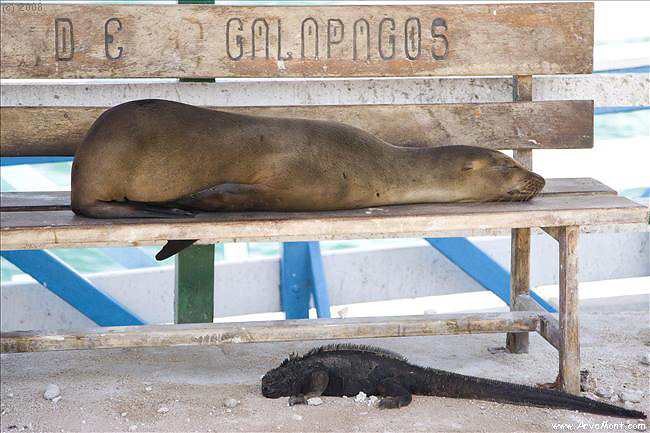
Sea Lion and Marine Iguana - Baltra, Galapagos Islands, Ecuador
This is probably one of the first
scenes many people see (Baltra is one of the 2 airport entry points for the
Galapagos). The animals are everywhere!
24-105mm f/4 at 105 mm on Canon EOS-1Ds Mark II. Cropped to 70% of full frame.
1/1000 sec f/4. ISO 400
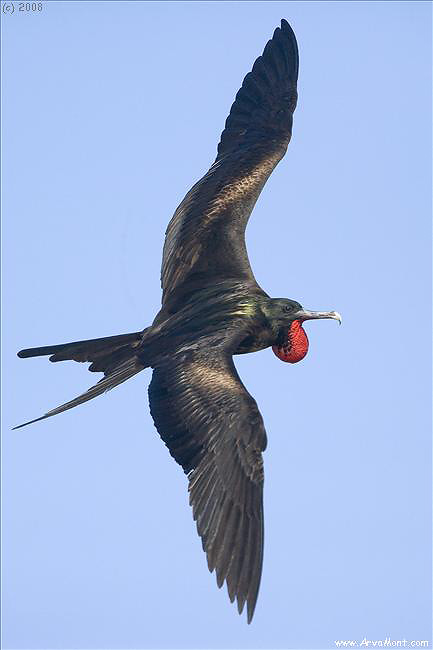
Magnificent Frigatebird - North Seymour, Galapagos Islands, Ecuador
300mm f/2.8 with 2X II TC on Canon EOS-1Ds Mark II. Cropped to 44% of full frame.
1/3200 sec f/5.6. ISO 400
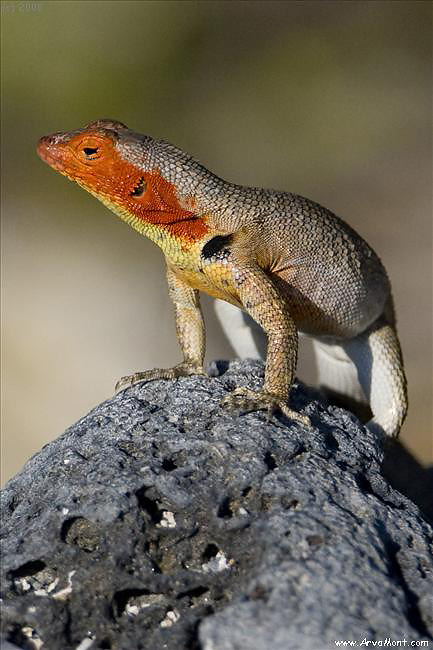
Lava Lizard - North Seymour, Galapagos Islands, Ecuador
300mm f/2.8 with 2X II TC on Canon EOS-1Ds Mark II. Cropped to 8% of full frame.
1/3200 sec f/5.6. ISO 400
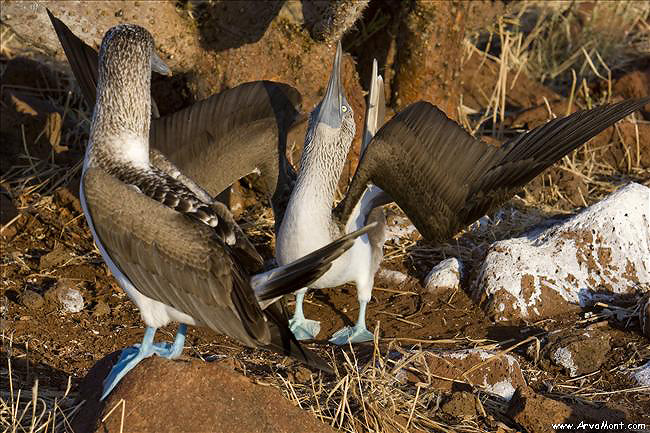
"Yo, look over here" - these two eventually "paired up."
Blue Footed Booby "Skypointing" (displaying) - North Seymour, Galapagos Islands, Ecuador
70-200mm f/2.8 at 145 mm on Canon EOS-1Ds Mark II. Cropped to 36% of full frame.
1/500 sec f/8. ISO 400
One thing you may notice about
some of the ground photos - there is a lot of clutter and bird "whitewash" (aka
poop) everywhere. Even shooting "wide open" won't eliminate this stuff, and
while photographing with a group, it may be hard to get a good position that
reduces the visibility of some of these elements. To compensate, try to
get as low to the ground as you can, and/or wait for the group to move to get
into a prime position, and/or simply take turns with other photographers in the
prime spot(s). Sometimes there isn't a prime spot, but it is always worth
trying to find it since the clutter can be distracting. The photo
above was taken with a shorter lens from a standing position. In the photo
below, I switched to a longer focal length (I quadrupled it basically) and got
lower to the ground. I like the previous photo because it shows more
context, but it can get lost in the clutter of the background.
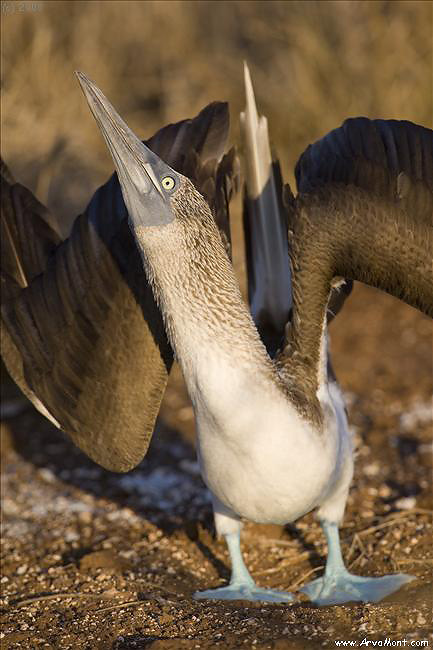
Blue Footed Booby "Skypointing" (displaying) - North Seymour, Galapagos Islands, Ecuador
300mm f/2.8 with 2X II TC on Canon EOS-1Ds Mark II. Cropped to 91% of full frame.
1/800 sec f/6.3. ISO 400
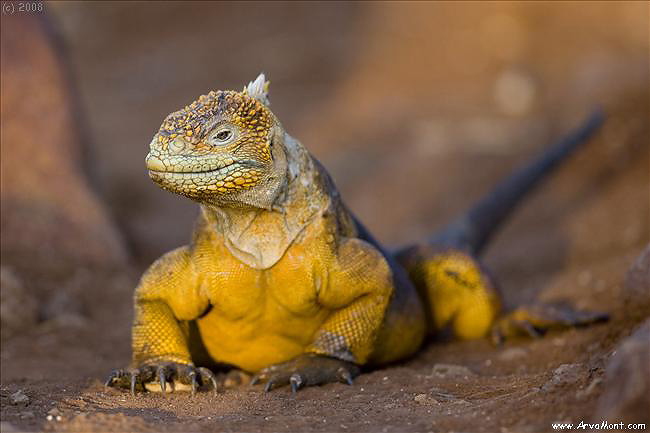
Land Iguana - North Seymour, Galapagos Islands, Ecuador
Again, getting lower to the
ground helps reduce some of the clutter and also results in a more intimate
image (rather than looking like you're standing over the animal).
300mm f/2.8 on Canon EOS-1Ds Mark II. Cropped to 40% of full frame.
1/640 sec f/2.8. ISO 400
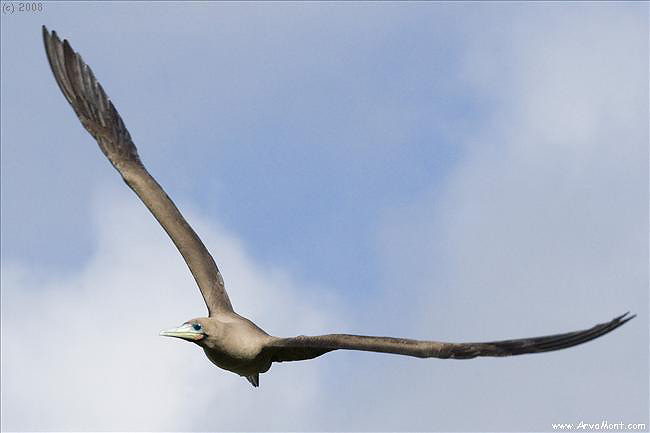
Red-footed Booby - Darwin Bay, Tower Island, Galapagos Islands, Ecuador
100-400mm f/4.5-5.6 at 135 mm on Canon EOS-1Ds Mark II. Cropped to 15% of full frame.
1/1250 sec f/10. ISO 400
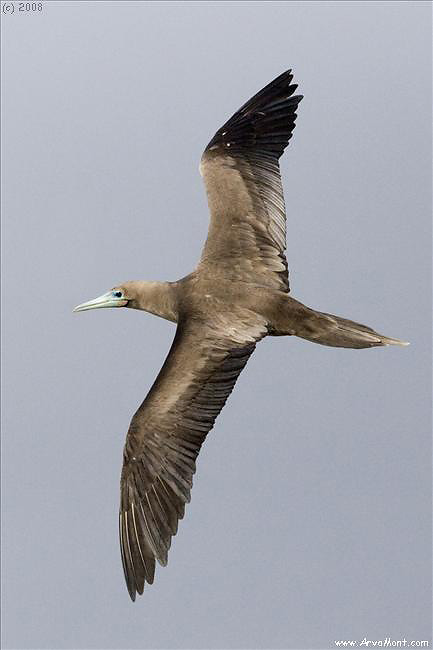
Red-footed Booby - Darwin Bay, Tower Island, Galapagos Islands, Ecuador
300mm f/2.8 on Canon EOS-1Ds Mark II. Cropped to 13% of full frame.
1/6400 sec f/5. ISO 400
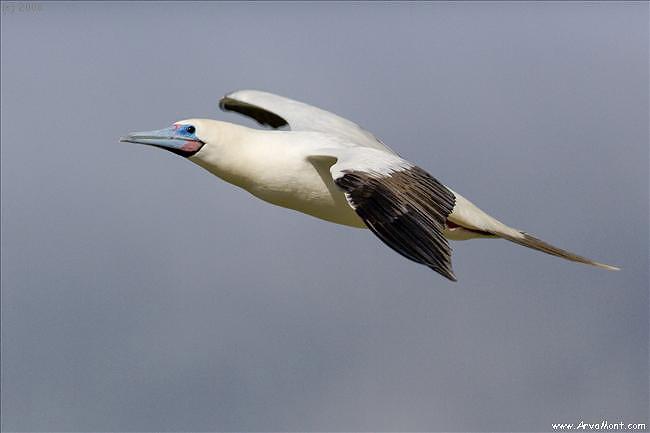
Red-footed Booby - Darwin Bay, Tower Island, Galapagos Islands, Ecuador
300mm f/2.8 on Canon EOS-1Ds Mark II. Cropped to 36% of full frame.
1/8000 sec f/5. ISO 400
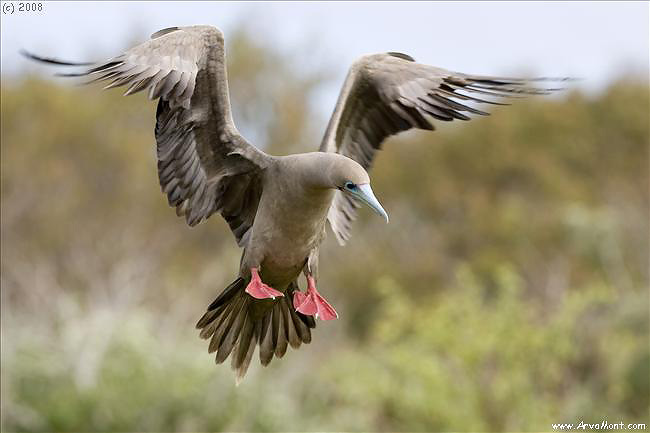
Red-footed Booby - Darwin Bay, Tower Island, Galapagos Islands, Ecuador
300mm f/2.8 on Canon EOS-1Ds Mark II. Cropped to 46% of full frame.
1/500 sec f/5.6. ISO 200
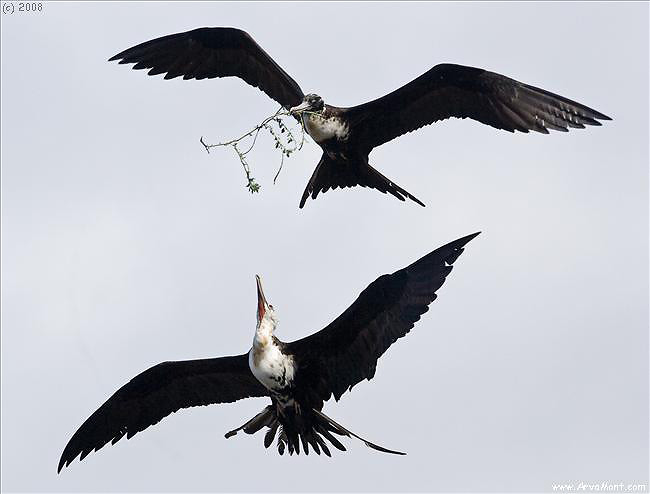
Juvenile Frigatebird (lower) harassing female Frigatebird (upper) - Darwin Bay, Tower Island, Galapagos Islands, Ecuador
Frigatebirds are notorious for
harassing other birds and each other. It can really make for some
interesting aerial antics.
300mm f/2.8 on Canon EOS-1Ds Mark II. Cropped to 25% of full frame.
1/2500 sec f/5.6. ISO 200
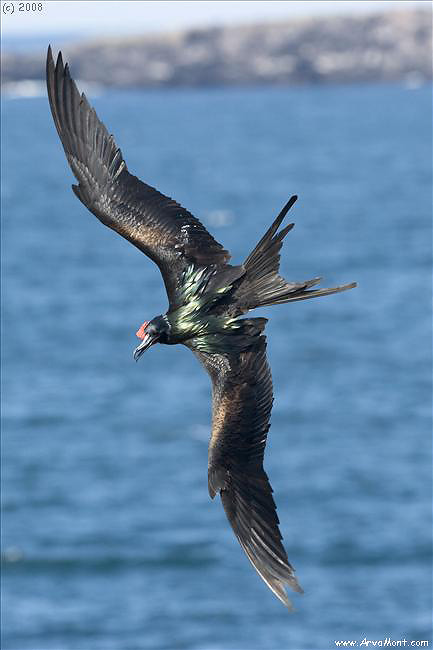
Frigagebird - Darwin Bay, Tower Island, Galapagos Islands, Ecuador
When photographing these birds,
make sure you aren't using a polarizing filter - it can eliminate the
iridescent color on their backs.
300mm f/2.8 on Canon EOS-1Ds Mark II. Cropped to 36% of full frame.
1/1000 sec f/5. ISO 200
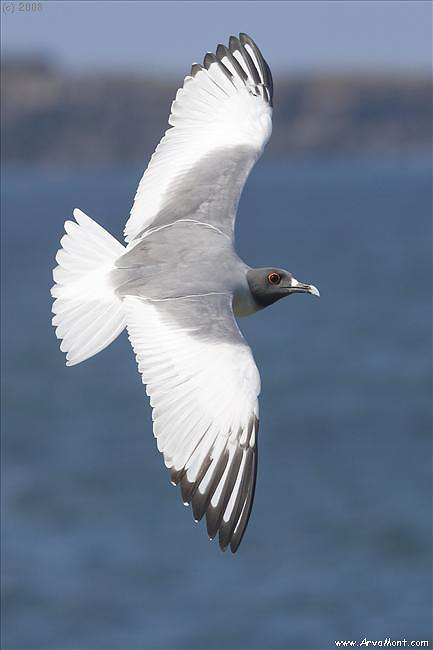
Swallow-tailed Gull - Darwin Bay, Tower Island, Galapagos Islands, Ecuador
300mm f/2.8 on Canon EOS-1Ds Mark II. Cropped to 19% of full frame.
1/1000 sec f/5.6. ISO 200
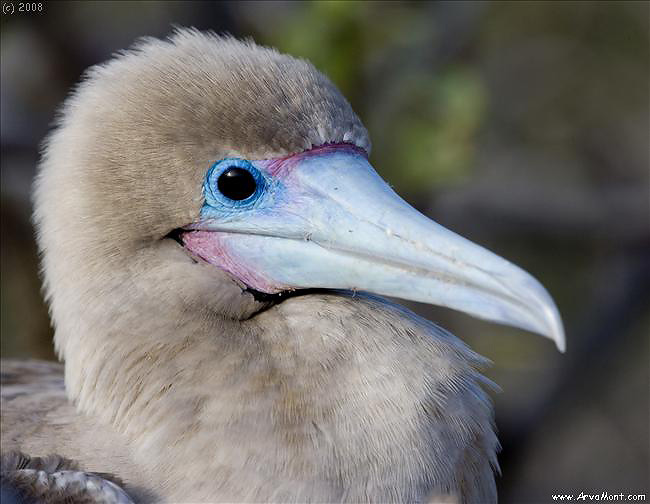
Red-footed Booby - Prince Philip's Steps, Tower Island, Galapago Islands, Ecuador
When shooting portraits from
closer in, don't forget to choose a smaller aperture (higher 'f' number) to
increase the depth of field. That will help get more of the subject in
focus - especially if you can't get it completely square with the plane of
the image sensor (the film plane in the "old days" :-) ).
100-400mm f/4.5-5.6 at 400 mm on Canon EOS-1Ds Mark II. Cropped to 79% of full frame.
1/400 sec f/11. ISO 400
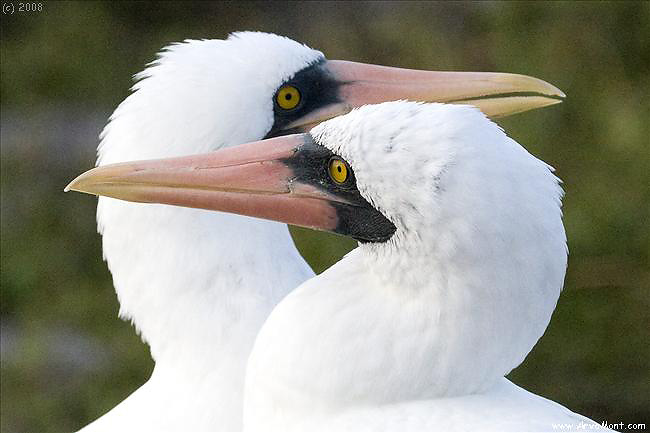
Nazca Boobies - Prince Philip's Steps, Tower Island, Galapago Islands, Ecuador
100-400mm f/4.5-5.6 at 170 mm on Canon EOS-1Ds Mark II. Cropped to 10% of full frame.
1/1600 sec f/7.1. ISO 800
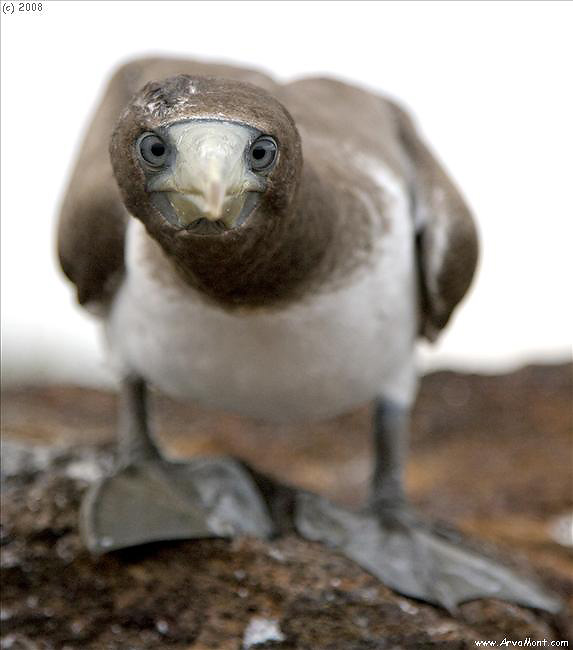
Juvenile Nazca Booby - Prince Philip's Steps, Tower Island, Galapago Islands, Ecuador
It's funny how tame and curious
these guys are. Getting low to the ground (i.e. laying down) can lead
to some nice shots with clean backgrounds.
24-105mm f/4 at 105 mm on Canon EOS-1Ds Mark II. Cropped to 39% of full frame.
1/1000 sec f/4. ISO 800
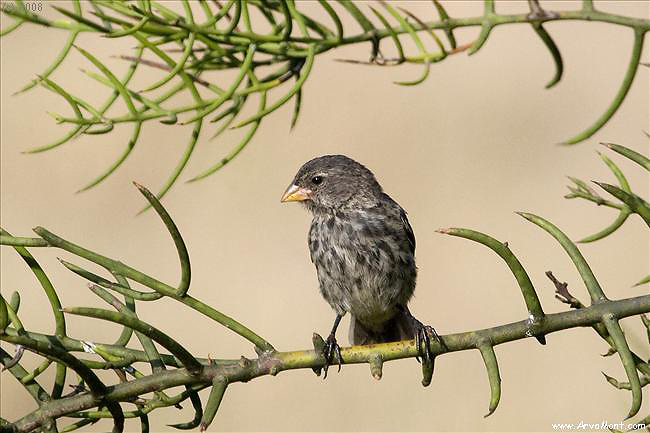
Medium Ground Finch - Urvina Bay, Isabela Island, Galapagos Islands, Ecuador
I like how the bird is turned in the same direction as the
thorns.
100-400mm f/4.5-5.6 at 400 mm on Canon EOS-1Ds Mark II. Cropped to 10% of full frame.
1/2500 sec f/5.6. ISO 400
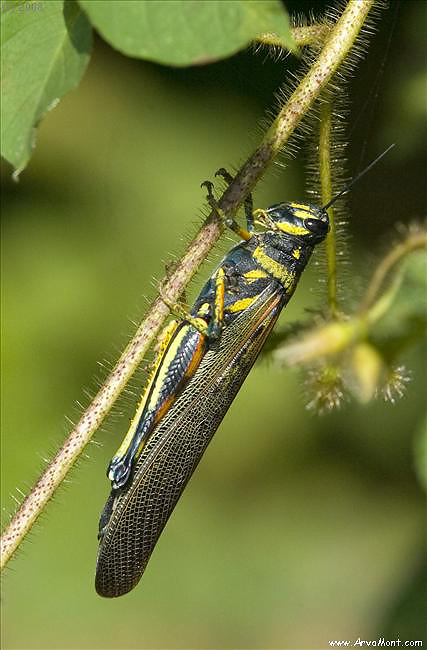
Locust - Urvina Bay, Isabela Island, Galapagos Islands, Ecuador
300mm f/2.8 on Canon EOS-1Ds Mark II. Cropped to 14% of full frame.
1/2500 sec f/6.3. ISO 400
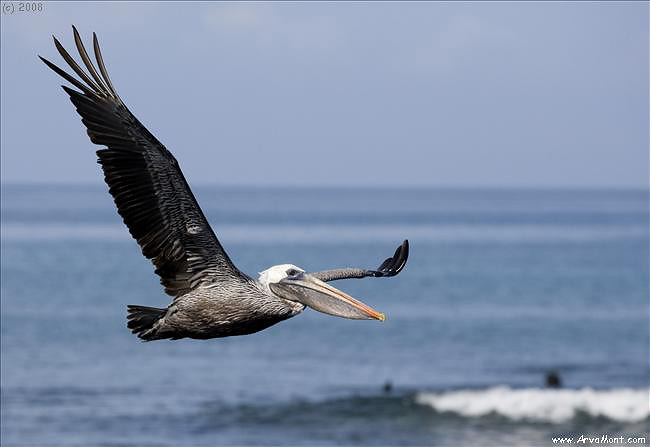
Brown Pelican - Urvina Bay, Isabela Island, Galapagos Islands, Ecuador
100-400mm f/4.5-5.6 at 275 mm on Canon EOS-1Ds Mark II. Cropped to 61% of full frame.
1/2000 sec f/7.1. ISO 400
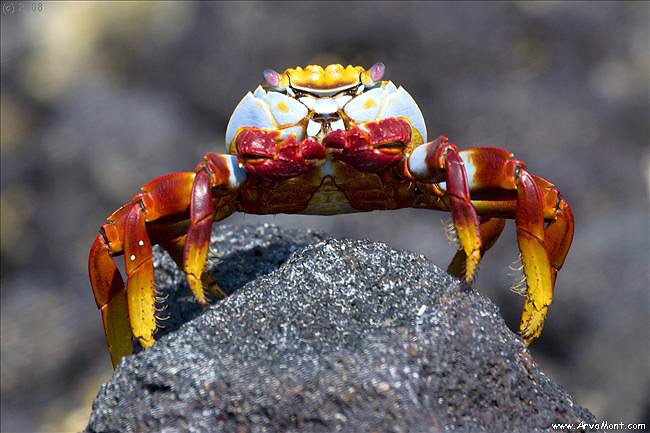
Sally Lightfoot Crab - Urvina Bay, Isabela Island, Galapagos Islands, Ecuador
These guys are everywhere and
their colors are often quite a contrast to their background. Try to
avoid peak day sunlight on them since they can really have some really
bright reflections. I also like a little more depth of field to try to
get the eyes and front claws in focus.
100-400mm f/4.5-5.6 at 400 mm on Canon EOS-1Ds Mark II. Cropped to 42% of full frame.
1/1250 sec f/8. ISO 400
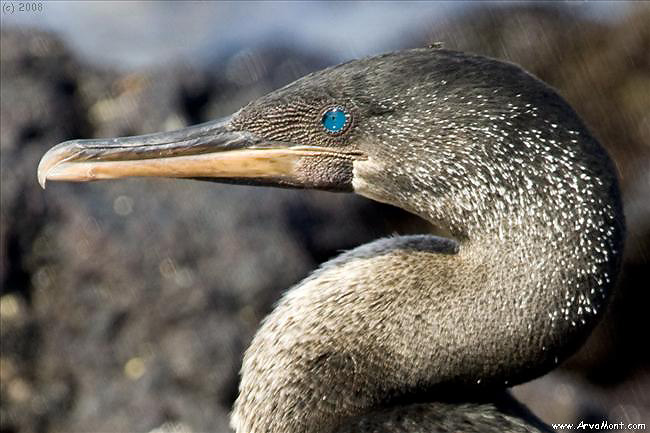
Flightless Cormorant - Urvina Bay, Isabela Island, Galapagos Islands, Ecuador
The eyes of the cormorant are a
pretty emerald color.
100-400mm f/4.5-5.6 at 400 mm on Canon EOS-1Ds Mark II. Cropped to 7% of full frame.
1/500 sec f/8. ISO 400
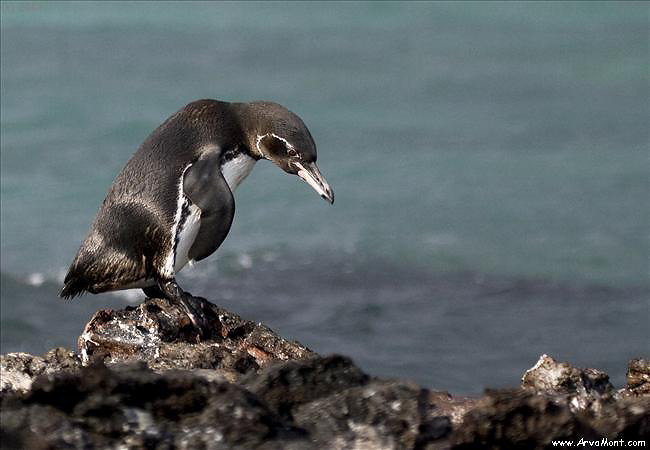
Galapagos Penguin - Elizabeth Bay, Isabella Island, Galapagos Islands, Ecuador
It's still bizarre, to me, to see
penguins at the equator.
100-400mm f/4.5-5.6 at 120 mm on Canon EOS-1Ds Mark II. Cropped to 16% of full frame.
1/4000 sec f/4.5. ISO 400
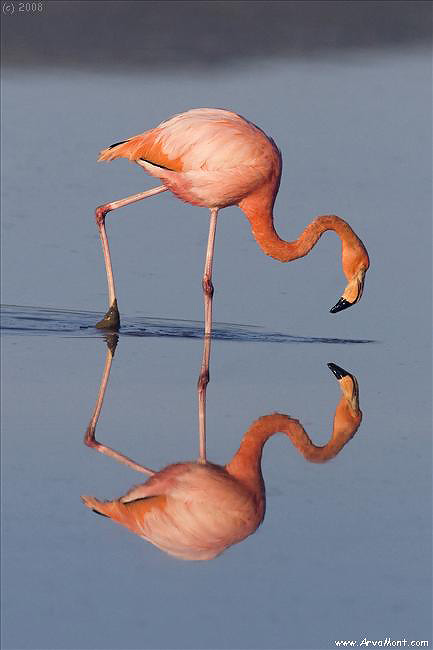
Greater Flamingo - Punta Cormorant, Floreana Island, Galapagos Islands, Ecuador
300mm f/2.8 on Canon EOS-1Ds Mark II. Cropped to 14% of full frame.
1/2500 sec f/4.5. ISO 200
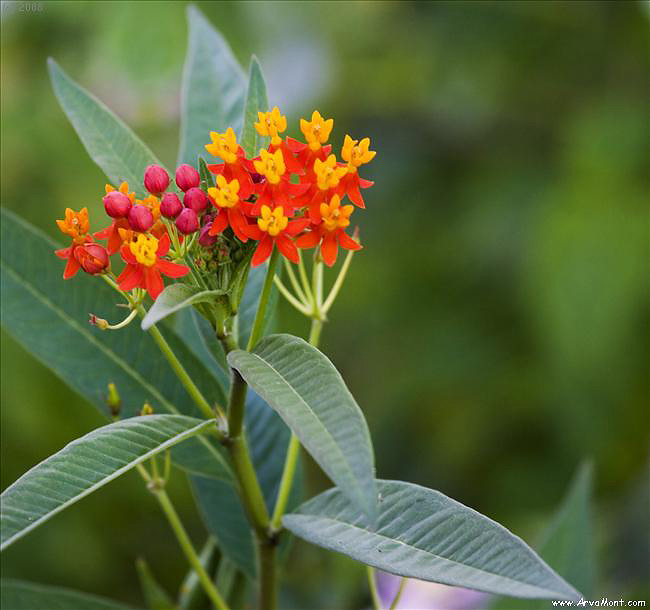
Puerto Beiasco Ibarra, Floreana Island, Galapagos Islands, Ecuador
100-400mm f/4.5-5.6 at 365 mm on Canon EOS-1Ds Mark II. Cropped to 40% of full frame.
1/160 sec f/5.6. ISO 400
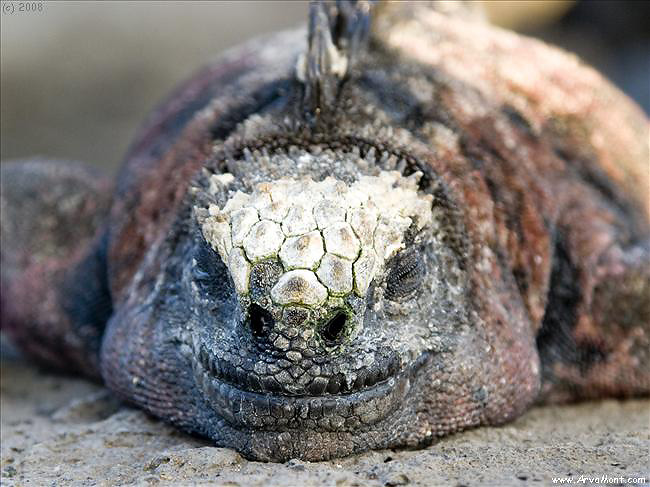
Marine Iguana - Puerto Velasco Ibarra, Floreana Island, Galapagos Islands, Ecuador
24-105mm f/4 at 105 mm on Canon EOS-1Ds Mark II. Cropped to 18% of full frame.
1/200 sec f/5. ISO 400
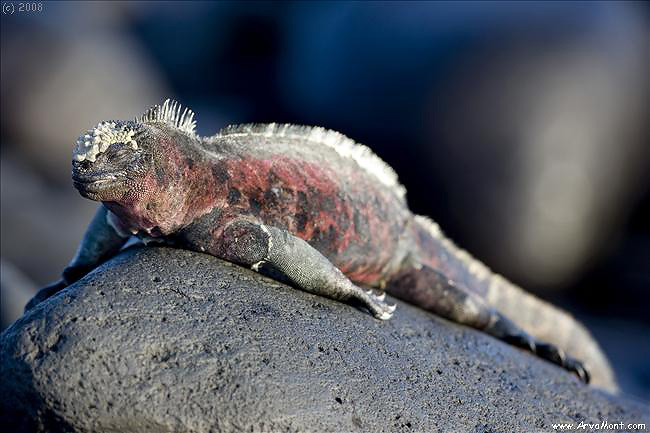
Marine Iguana - Punta Suarez, Espanola Island, Galapagos Islands, Ecuador
300mm f/2.8 on Canon EOS-1Ds Mark II.
1/400 sec f/4.5. ISO 400
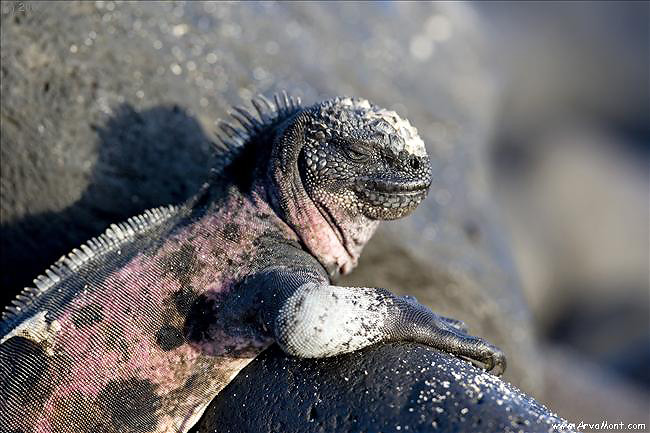
Marine Iguana - Punta Suarez, Espanola Island, Galapagos Islands, Ecuador
300mm f/2.8 on Canon EOS-1Ds Mark II.
1/500 sec f/4.5. ISO 400
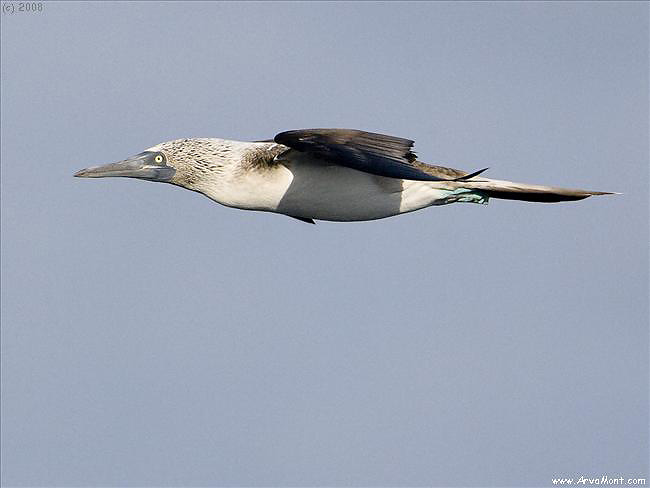
Blue-footed Booby - Punta Suarez, Espanola Island, Galapagos Islands, Ecuador
300mm f/2.8 with 2X II TC on Canon EOS-1Ds Mark II. Cropped to 11% of full frame.
1/4000 sec f/5.6. ISO 400
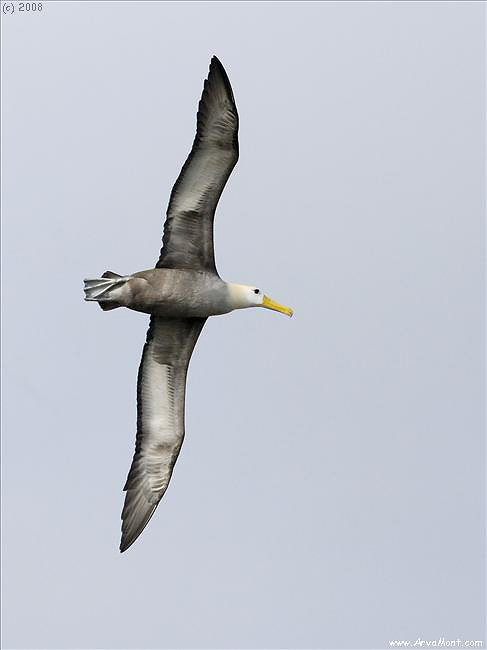
Waved Albatross - Punta Suarez, Espanola Island, Galapagos Islands, Ecuador
300mm f/2.8 on Canon EOS-1Ds Mark II. Cropped to 22% of full frame.
1/4000 sec f/5.6. ISO 400
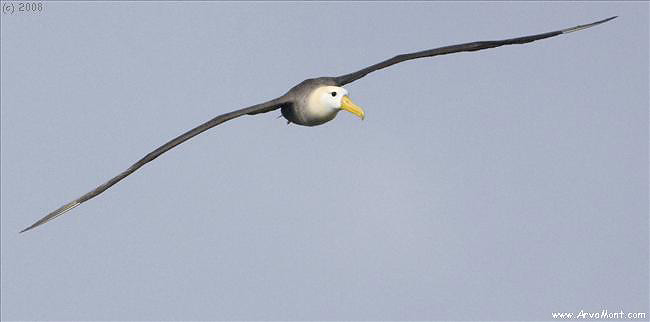
Waved Albatross - Punta Suarez, Espanola Island, Galapagos Islands, Ecuador
300mm f/2.8 with 2X II TC on Canon EOS-1Ds Mark II. Cropped to 8% of full frame.
1/4000 sec f/5.6. ISO 400
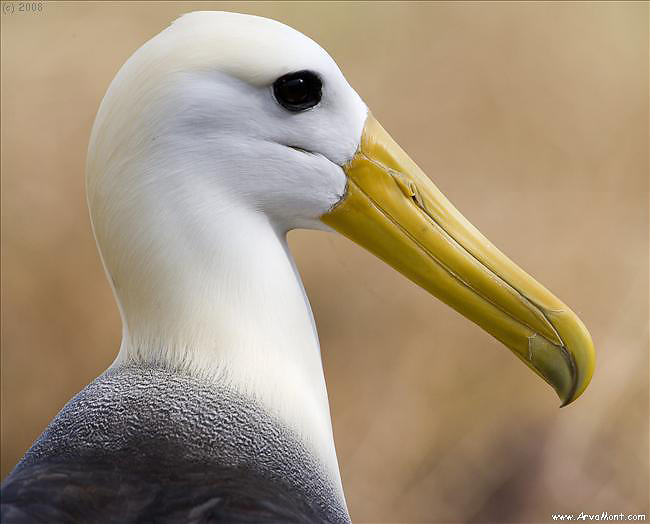
Waved Albatross - Punta Suarez, Espanola Island, Galapagos Islands, Ecuador
Even though the Waved Albatross
are everywhere on this island, it can be difficult to get close to one with
an uncluttered background. In this image, I was at 600mm and still
cropped about 20% of the frame off. Espanola was the only island on
which I carried a tripod - I really wanted to be able to get some nice clean
shots of the albatross.
300mm f/2.8 with 2X II TC on Canon EOS-1Ds Mark II. Cropped to 83% of full frame.
1/800 sec f/8. ISO 400
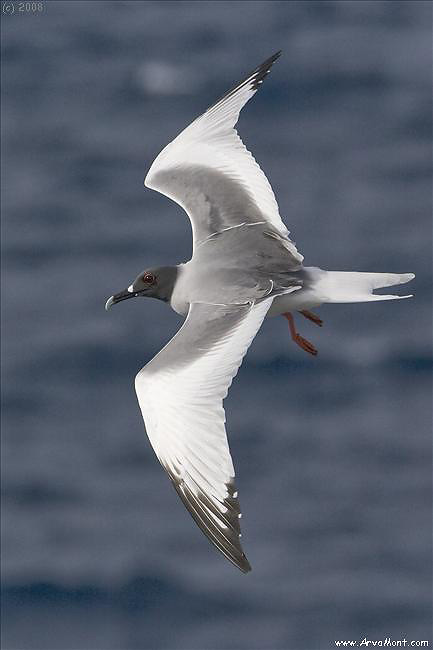
Swallow-tailed Gull - Punta Suarez, Espanola Island, Galapagos Islands, Ecuador
300mm f/2.8 on Canon EOS-1Ds Mark II. Cropped to 18% of full frame.
1/4000 sec f/5.6. ISO 400
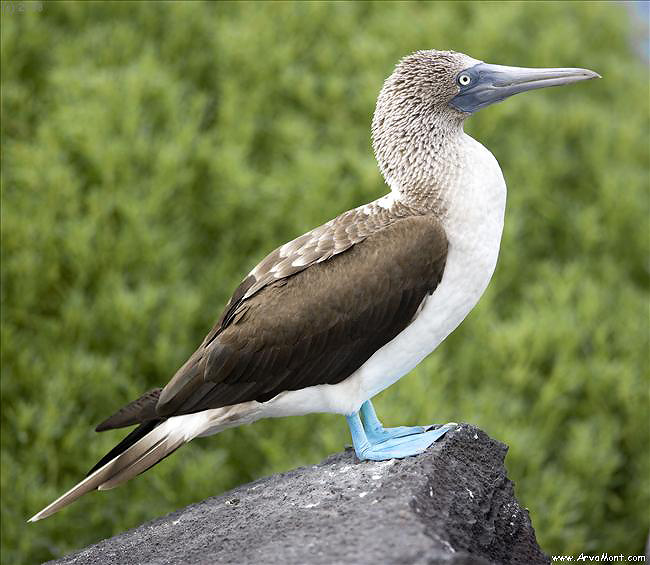
Blue-footed Booby - Punta Suarez, Espanola Island, Galapagos Islands, Ecuador
I think that the overcast gives
this a nice, even light. Outside of the sweet light shortly after
sunrise and before sunset, I tend to prefer a slight overcast to direct,
harsh sunlight. In the Galapagos, sunrise and sunset times don't vary
much throughout the year. The sweetest light, therefore occurs before
about 7:30 or 8AM and after 4 or 4:30PM. If you're shooting outside
these times, hopefully you'll have some thin clouds to reduce some of the
harshness of the sunlight (but don't forget your sunscreen since you can
still get a nice sunburn when it's cloudy).
300mm f/2.8 on Canon EOS-1Ds Mark II. Cropped to 71% of full frame.
1/1250 sec f/2.8. ISO 200
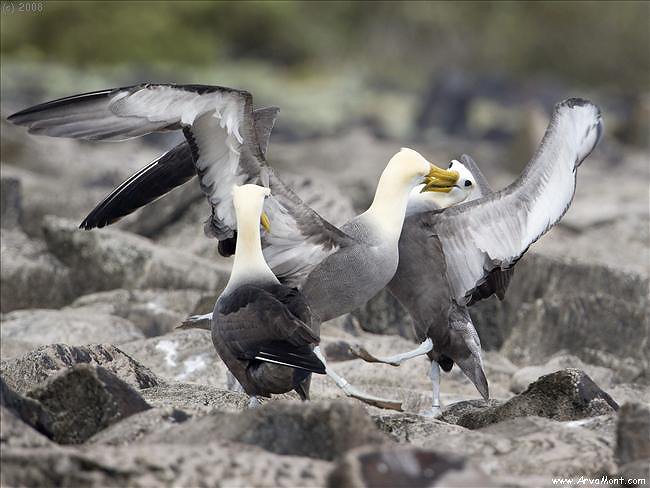
Waved Albatross - Punta Suarez, Espanola Island, Galapagos Islands, Ecuador
Generally, these birds were cute
doing their courtship rituals for us. But these two had a bit of a
squabble - ouch. This image is basically what would be a full frame in
a 1.6X body (i.e. Canon 40D, Rebel, etc) with a 600mm lens. In my
case, I had to crop off 60%. Oh how I envied the guys shooting with
cropped sensors here :-)
300mm f/2.8 with 2X II TC on Canon EOS-1Ds Mark II. Cropped to 41% of full frame.
1/800 sec f/5.6. ISO 200
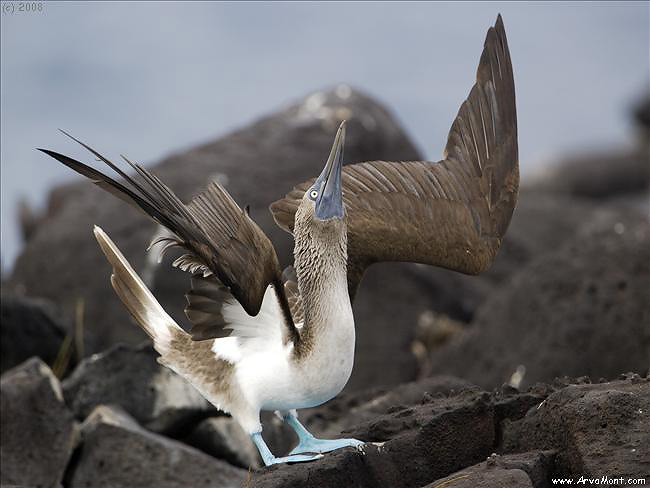
Blue-footed Booby - Punta Suarez, Espanola Island, Galapagos Islands, Ecuador
300mm f/2.8 with 2X II TC on Canon EOS-1Ds Mark II. Cropped to 60% of full frame.
1/640 sec f/5.6. ISO 200
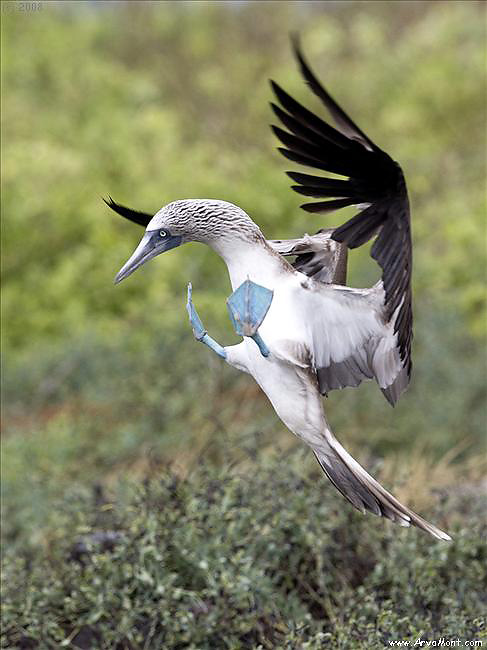
Blue-footed Booby - Punta Suarez, Espanola Island, Galapagos Islands, Ecuador
I love how the Blue-footed
Boobies land. I read that they throw their feet up as speed brakes.
Hard to believe that they would create a lot of drag, but it still is
entertaining to watch these guys come in.
300mm f/2.8 on Canon EOS-1Ds Mark II. Cropped to 34% of full frame.
1/1250 sec f/4.5. ISO 200
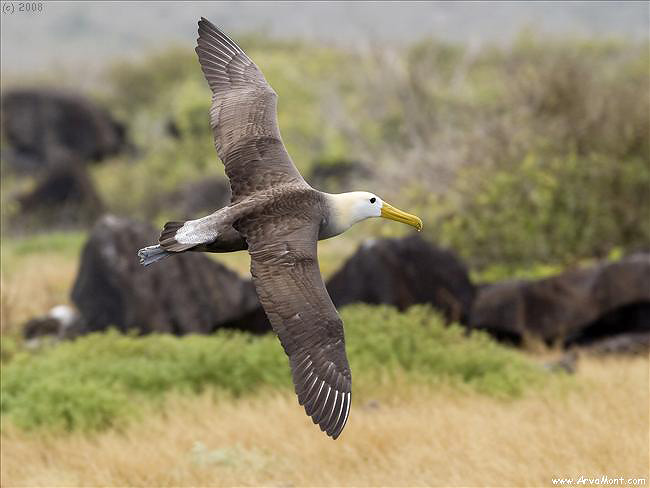
Waved Albatross - Punta Suarez, Espanola Island, Galapagos Islands, Ecuador
300mm f/2.8 on Canon EOS-1Ds Mark II. Cropped to 25% of full frame.
1/800 sec f/5.6. ISO 200
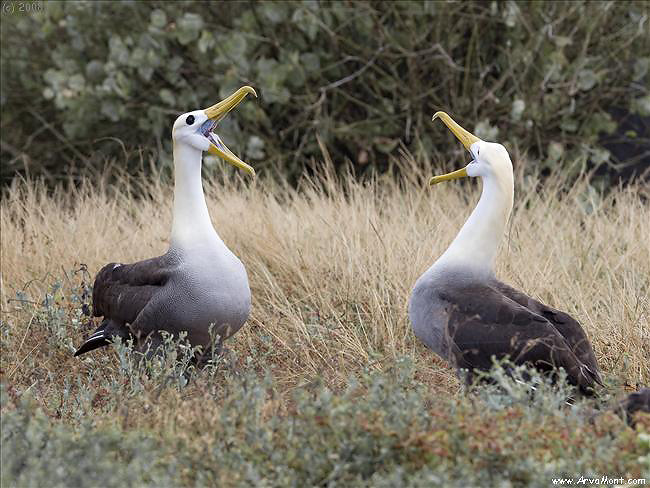
Waved Albatross - Punta Suarez, Espanola Island, Galapagos Islands, Ecuador
Courtship ritual.
300mm f/2.8 on Canon EOS-1Ds Mark II. Cropped to 32% of full frame.
1/800 sec f/5.6. ISO 200
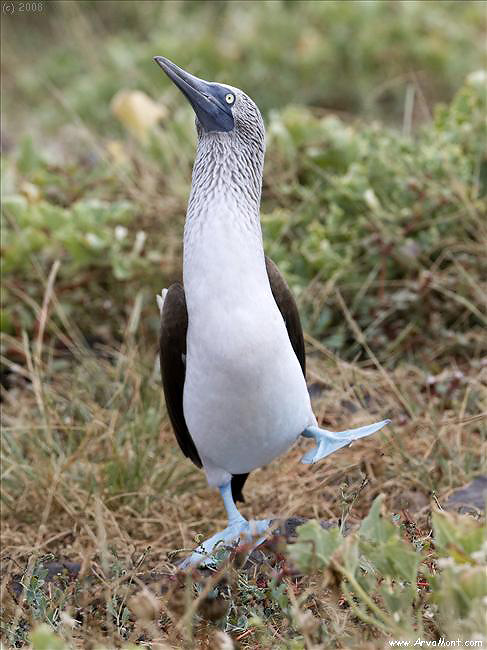
Blue-footed Booby - Punta Suarez, Espanola Island, Galapagos Islands, Ecuador
300mm f/2.8 on Canon EOS-1Ds Mark II. Cropped to 27% of full frame.
1/1000 sec f/5.6. ISO 200
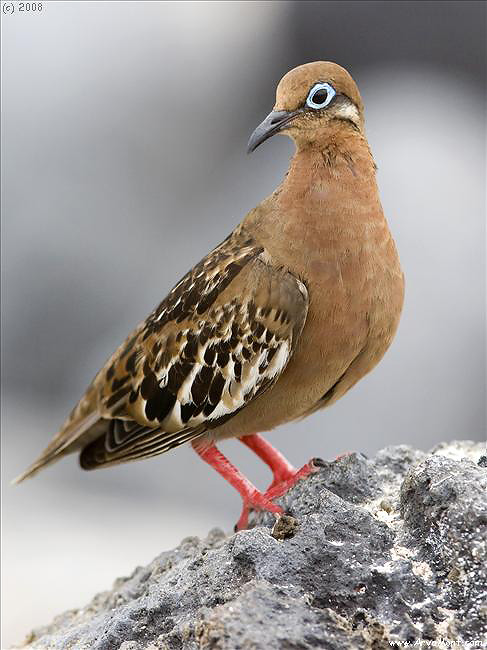
Galapagos Dove - Punta Suarez, Espanola Island, Galapagos Islands, Ecuador
300mm f/2.8 on Canon EOS-1Ds Mark II. Cropped to 24% of full frame.
1/1250 sec f/4.5. ISO 200
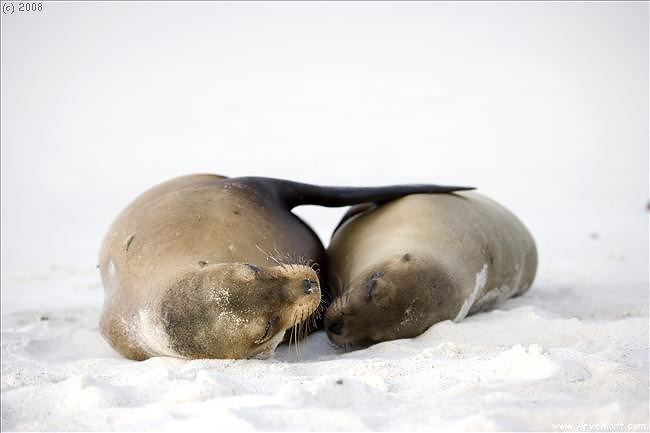
Sea lions - Gardner Bay, Espanola Island, Galapagos Islands, Ecuador
100-400mm f/4.5-5.6 at 250 mm on Canon EOS-1Ds Mark II.
1/320 sec f/5.6. ISO 400
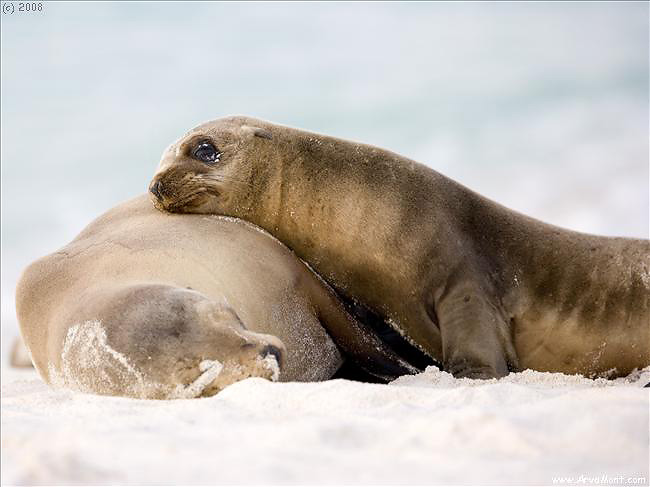
Sea lions - Gardner Bay, Espanola Island, Galapagos Islands, Ecuador
100-400mm f/4.5-5.6 at 310 mm on Canon EOS-1Ds Mark II. Cropped to 66% of full frame.
1/400 sec f/5.6. ISO 400
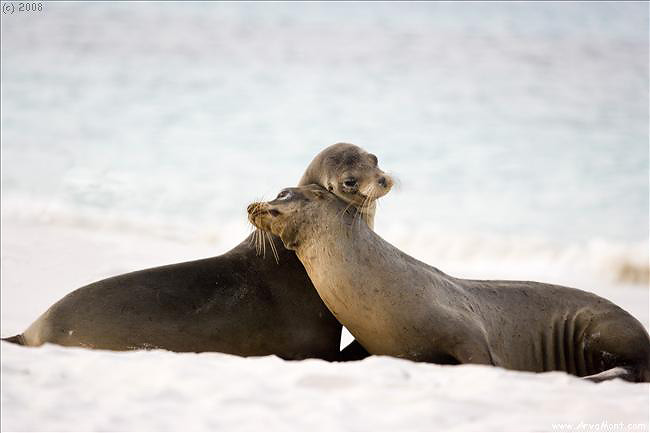
Sea lions - Gardner Bay, Espanola Island, Galapagos Islands, Ecuador
100-400mm f/4.5-5.6 at 300 mm on Canon EOS-1Ds Mark II.
1/320 sec f/5.6. ISO 400
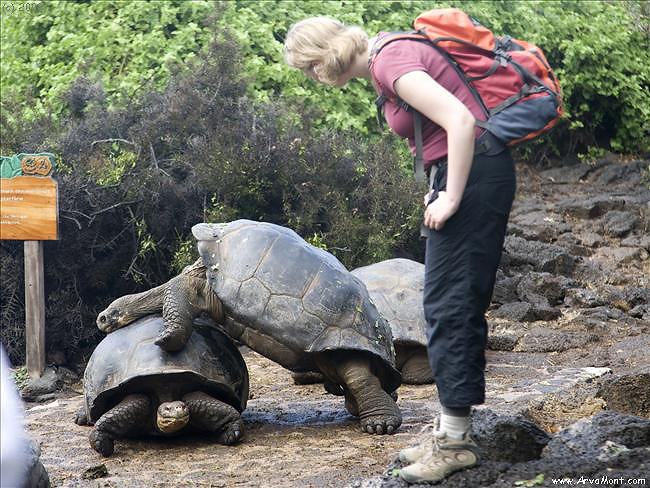
Charles Darwin Research Station (CDRS), Puerto Ayora, Santa Cruz Island, Galapagos Islands, Ecuador
24-105mm f/4 at 105 mm on Canon EOS-1Ds Mark II. Cropped to 65% of full frame.
1/400 sec f/4.5. ISO 400
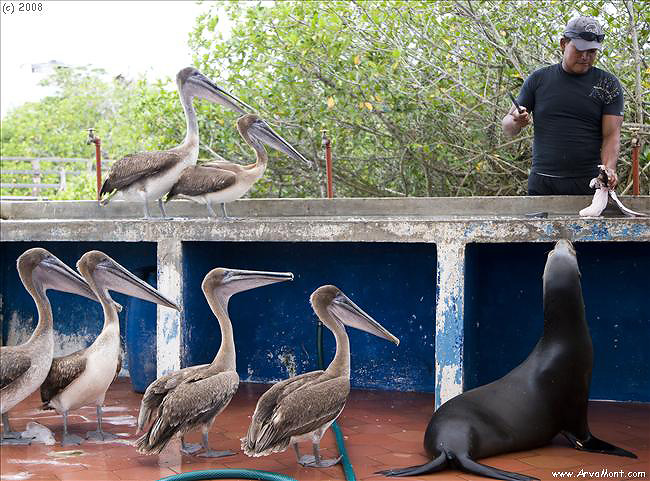
Puerto Ayora, Santa Cruz Island, Galapagos Islands, Ecuador
A roadside fish processing
station in downtown Puerto Ayora. The pelicans and sea lion sure seem
interested, eh?
24-105mm f/4 at 47 mm on Canon EOS-1Ds Mark II. Cropped to 72% of full frame.
1/500 sec f/4.5. ISO 400
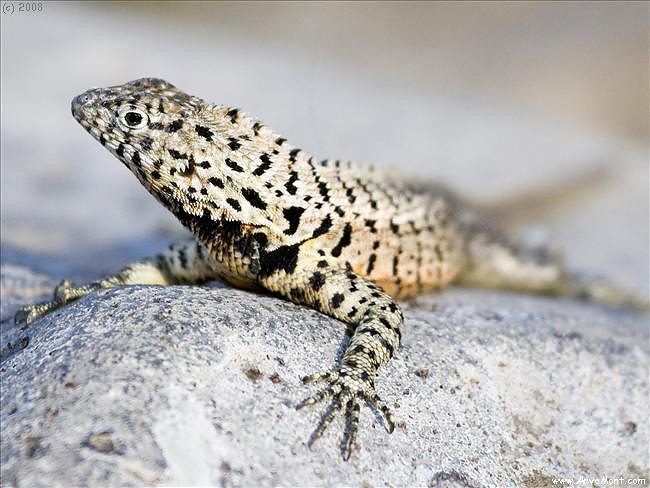
Lava Lizard - Santa Fe Island, Galapagos Islands, Ecuador
100-400mm f/4.5-5.6 at 400 mm on Canon EOS-1Ds Mark II. Cropped to 30% of full frame.
1/1600 sec f/5.6. ISO 400
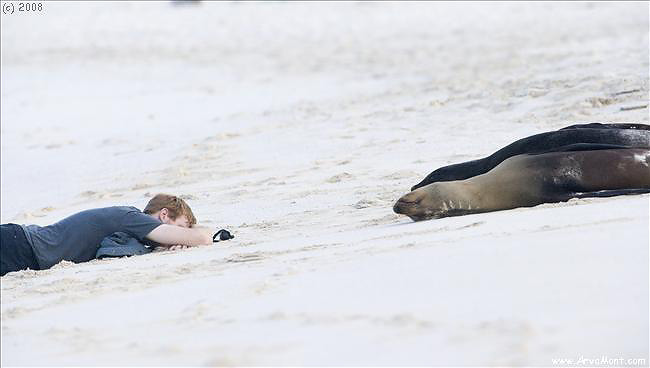
San Cristobal Island, Galapagos Islands, Ecuador
A popular place for napping :-)
300mm f/2.8 with 2X II TC on Canon EOS-1Ds Mark II. Cropped to 85% of full frame.
1/1600 sec f/8. ISO 800
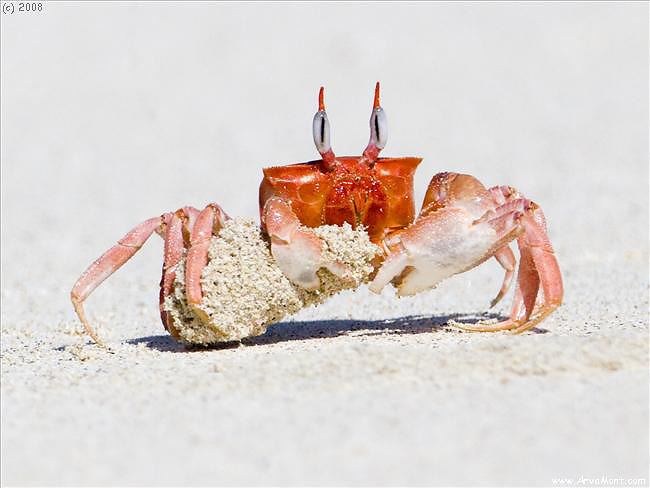
Ghost Crab - San Cristobal Island, Galapagos Islands, Ecuador
The 2 key items to photographing
Ghost Crabs: (1) get on your belly in the sand. (2) wait for everyone in the
group to leave. These crabs pick up the vibrations from walking people
and they run for cover. If you're alone (or with others that are
laying still), the crabs will come out and do their thing. Pick some
subjects down light (in the direction of your shadow), crawl as close as you
think you can, and then wait for them to pick up their activity again.
As you can see, even then you may not get very close - these images are 90%
crops at 600mm.
300mm f/2.8 with 2X II TC on Canon EOS-1Ds Mark II. Cropped to 11% of full frame.
1/5000 sec f/7.1. ISO 400
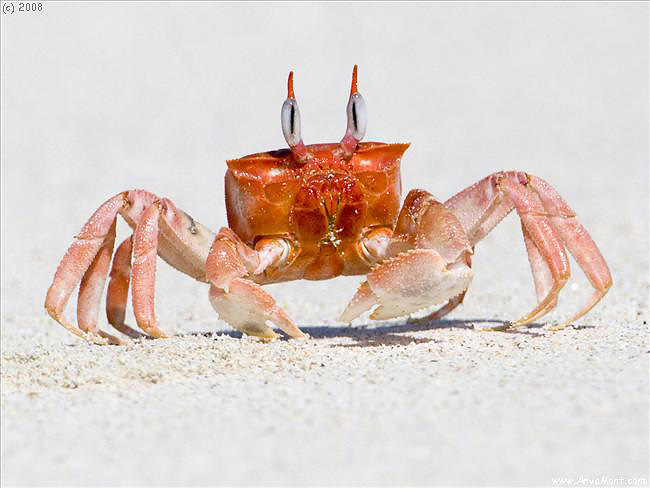
Ghost Crab - San Cristobal Island, Galapagos Islands, Ecuador
300mm f/2.8 with 2X II TC on Canon EOS-1Ds Mark II. Cropped to 9% of full frame.
1/5000 sec f/7.1. ISO 400
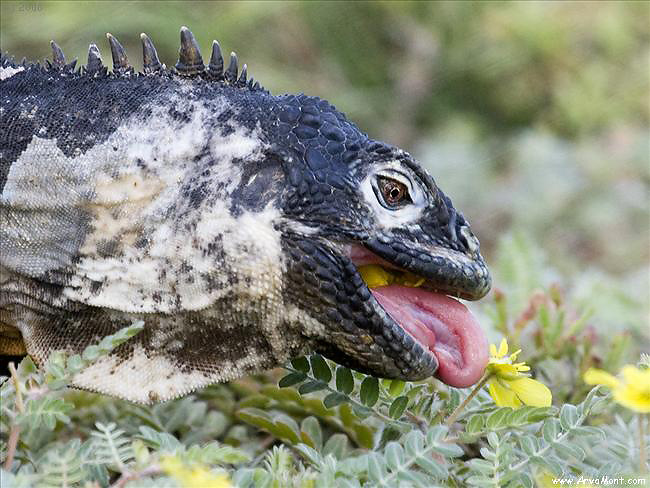
Marine Iguana - South Plaza Island, Galapagos Islands, Ecuador
100-400mm f/4.5-5.6 at 400 mm on Canon EOS-1Ds Mark II. Cropped to 8% of full frame.
1/640 sec f/6.3. ISO 400
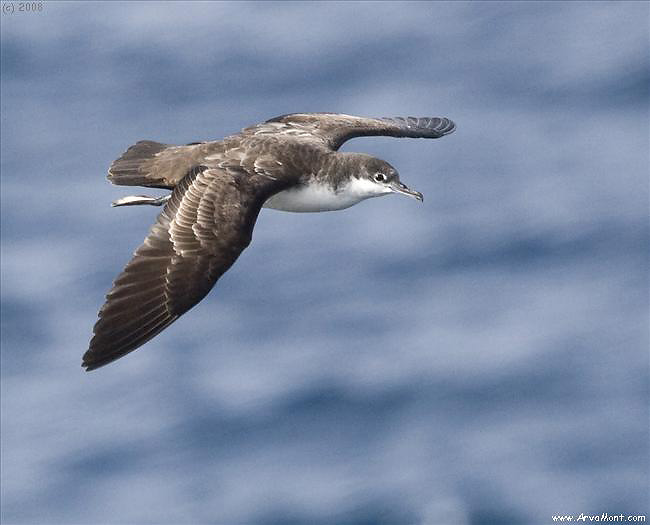
Shearwater - South Plaza Island, Galapagos Islands, Ecuador
100-400mm f/4.5-5.6 at 285 mm on Canon EOS-1Ds Mark II. Cropped to 8% of full frame.
1/1600 sec f/5.6. ISO 400
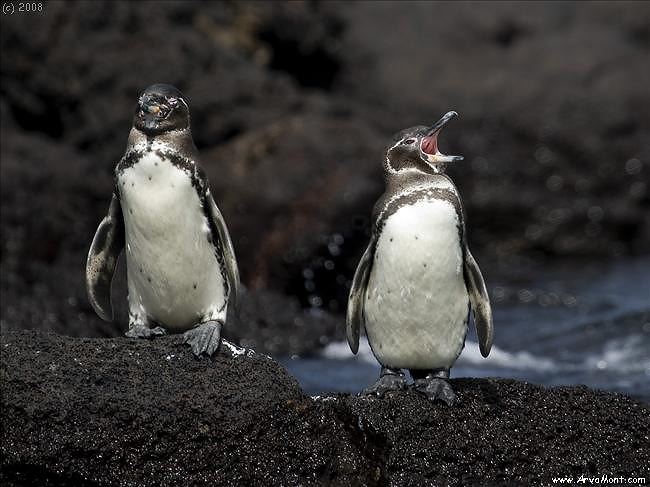
Galapagos Penguins - Bartolome Island, Galapagos Islands, Ecuador
100-400mm f/4.5-5.6 at 400 mm on Canon EOS-1Ds Mark II. Cropped to 26% of full frame.
1/1250 sec f/5.6. ISO 400
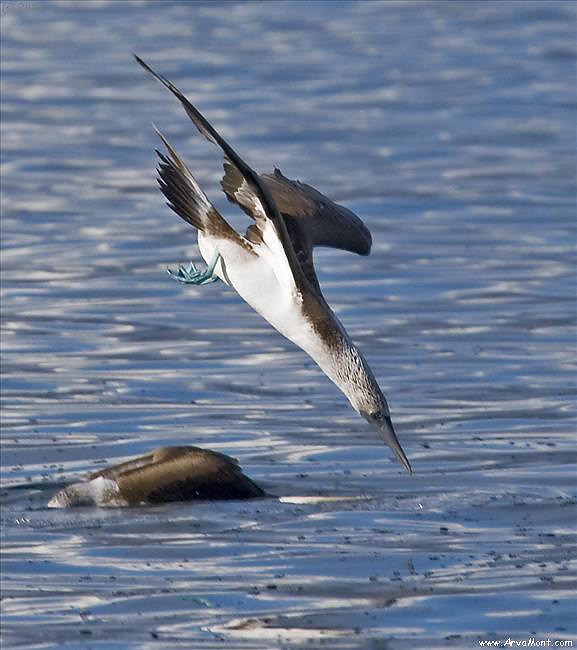
Blue-footed Booby - Black Turtle Cove, Santa Cruz Island, Galapagos Islands, Ecuador
100-400mm f/4.5-5.6 at 390 mm on Canon EOS-1Ds Mark II. Cropped to 7% of full frame.
1/1250 sec f/8. ISO 400
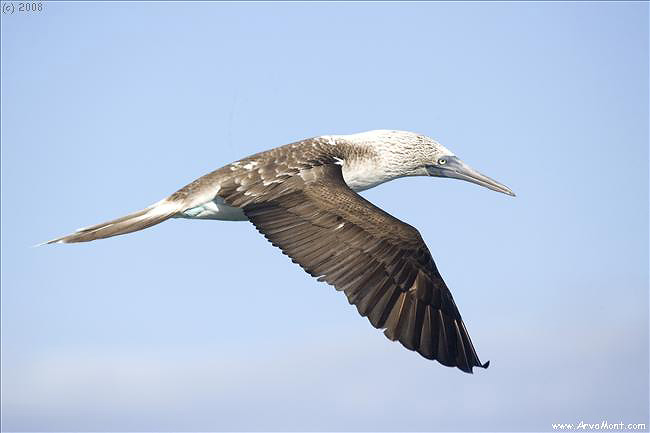
Blue-footed Booby - Black Turtle Cove, Santa Cruz Island, Galapagos Islands, Ecuador
These guys just look so "bored,"
don't they? But boy, there are fun to watch fishing.
100-400mm f/4.5-5.6 at 400 mm on Canon EOS-1Ds Mark II. Cropped to 75% of full frame.
1/2000 sec f/8. ISO 400
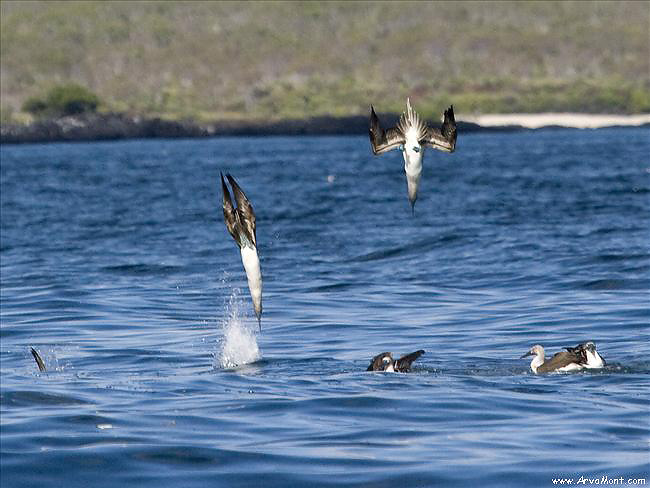
Blue-footed Boobies fishing - Black Turtle Cove, Santa Cruz Island, Galapagos Islands, Ecuador
100-400mm f/4.5-5.6 at 300 mm on Canon EOS-1Ds Mark II. Cropped to 9% of full frame.
1/3200 sec f/6.3. ISO 400
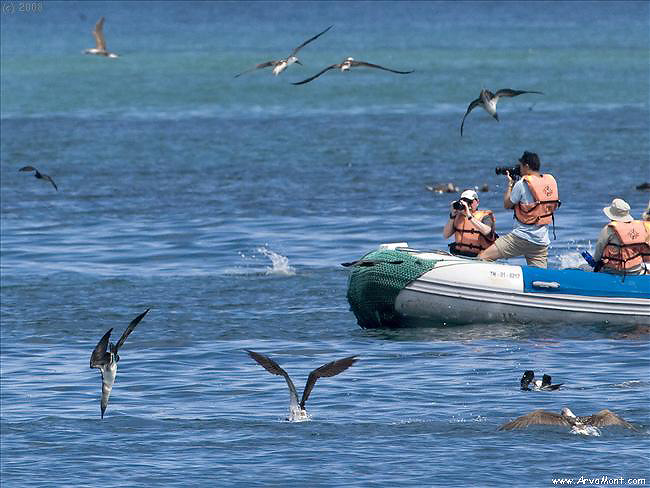
Blue-footed Boobies feeding frenzy - Black Turtle Cove, Santa Cruz Island, Galapagos Islands, Ecuador
Oh, I was so jealous of our
shipmates here - they were returning to the ship and spotted a feeding
frenzy and got right into the middle of it. Everywhere they looked,
there were Boobies diving! It looked awesome.
300mm f/2.8 with 2X II TC on Canon EOS-1Ds Mark II. Cropped to 14% of full frame.
1/1250 sec f/9. ISO 400
You will have many
opportunities to take pictures from a panga (dinghy). It's a good idea to
bring a plastic bag along to protect your camera from salt spray when you're not
photographing - it's often handier to put your camera in the plastic bag or
simply cover it with the plastic bag rather than put it back into your camera
case. Consider a dry bag for the wet landings just in case you lose your
footing while carrying your gear.
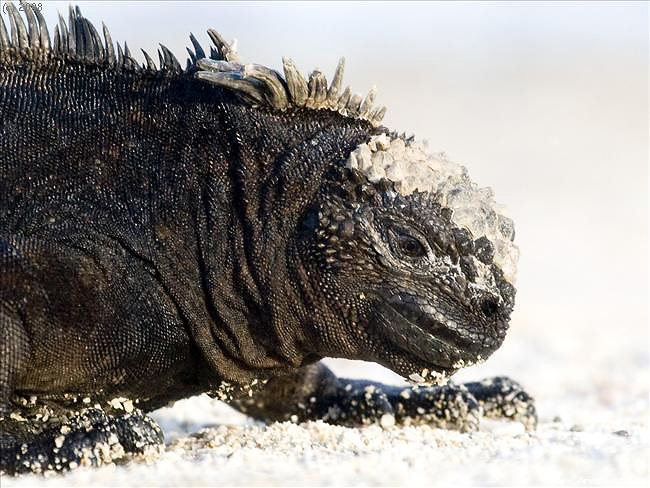
Marine Iguana - Las Bachas Beach, Santa Cruz Island, Galapagos Islands, Ecuador
100-400mm f/4.5-5.6 at 400 mm on Canon EOS-1Ds Mark II. Cropped to 10% of full frame.
1/500 sec f/6.3. ISO 400
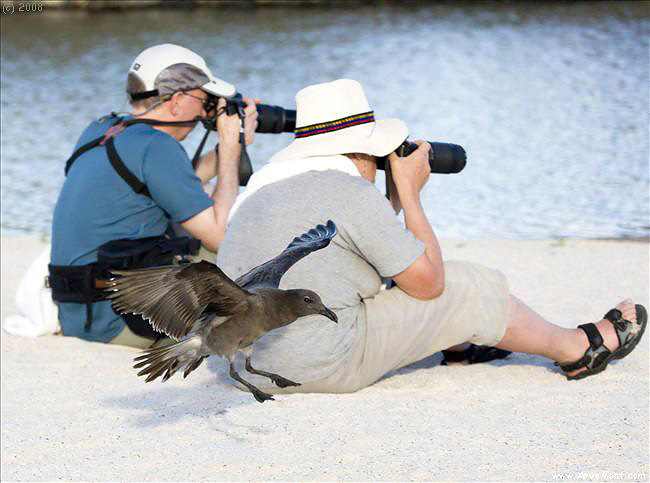
Lava Gull - Las Bachas Beach, Santa Cruz Island, Galapagos Islands, Ecuador
You have to love how tame these
animals are.
100-400mm f/4.5-5.6 at 160 mm on Canon EOS-1Ds Mark II. Cropped to 52% of full frame.
1/800 sec f/6.3. ISO 400
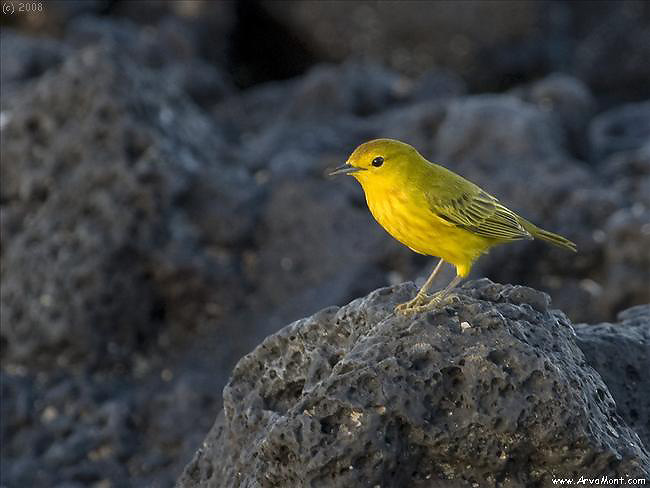
Yellow Warbler - Las Bachas Beach, Santa Cruz Island, Galapagos Islands, Ecuador
100-400mm f/4.5-5.6 at 400 mm on Canon EOS-1Ds Mark II. Cropped to 8% of full frame.
1/80 sec f/5.6. ISO 640
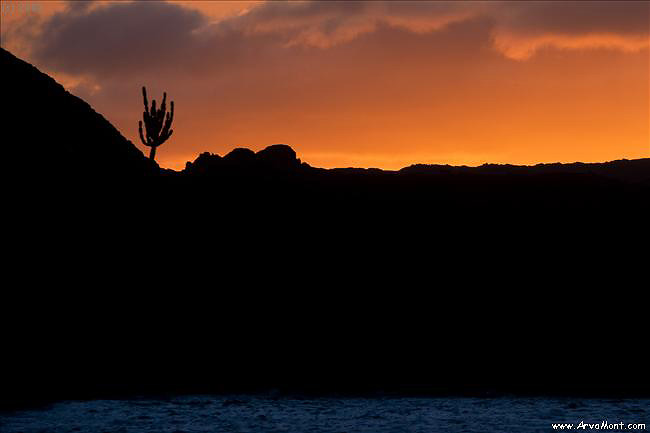
Sombrero Chino (Chinese Hat), Galapagos Islands, Ecuador
Don't forget to look around at
sunrise and sunset. If there are some clouds, the colors can be quite
spectacular.
100-400mm f/4.5-5.6 at 285 mm on Canon EOS-1Ds Mark II. Cropped to 45% of full frame.
1/400 sec f/6.3. ISO 400
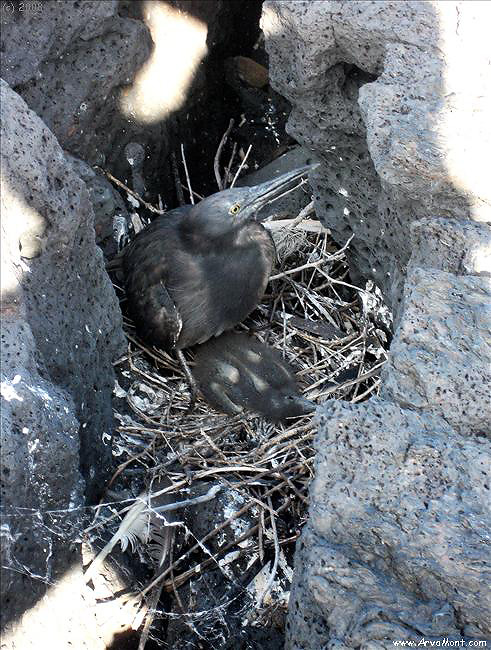
The above snapshot is
intended to provide context as to some of the challenges one may encounter in
photographing on the islands. In this case, harsh sunlight with
tough shadows cast by the surrounding rocks. To compensate, we shaded the
scene with our bodies to provide the subject area with a consistent, flat light
- this may not always be possible depending on light angle and terrain.
Then, since I couldn't get an angle with both subjects parallel to the plane of
the camera sensor, nor was there sufficient light to increase the depth of field
while maintaining a decent shutter speed for my off balance shooting stance, I
took two successive shots and created a composite. One shot focused on the
parent, the other on the chick. The merged photo appears below. Some
purists will argue it's not a true photo, but I think that it captures the scene
accurately and makes up for the limitations of the available camera gear at the
time (e.g. lack of a tripod which would have given me another option for
stopping down and increasing the depth of field).
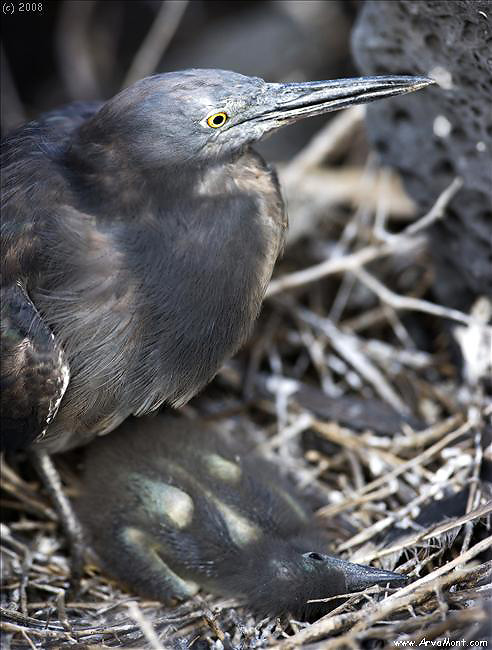
Galapagos (Lava) Heron with chick - Puerto Egas, Santiago Island, Galapagos Islands, Ecuador
100-400mm f/4.5-5.6 at 285 mm on Canon EOS-1Ds Mark II. Cropped to 45% of full frame.
1/400 sec f/6.3. ISO 400
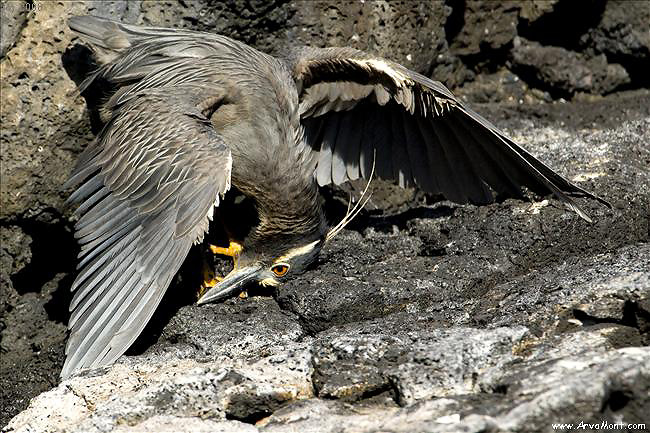
Yellow-crowned Night Heron - Puerto Egas, Santiago Island, Galapagos Islands, Ecuador
300mm f/2.8 with 2X II TC on Canon EOS-1Ds Mark II. Cropped to 51% of full frame.
1/1250 sec f/8. ISO 400
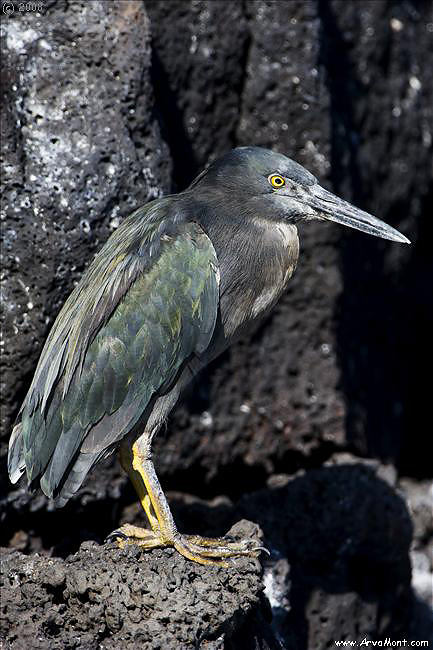
Galapagos (aka Lava) Heron - Puerto Egas, Santiago Island, Galapagos Islands, Ecuador
300mm f/2.8 with 2X II TC on Canon EOS-1Ds Mark II. Cropped to 44% of full frame.
1/800 sec f/5.6. ISO 400































































